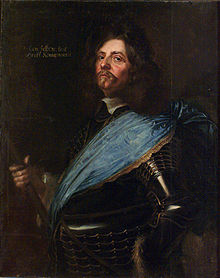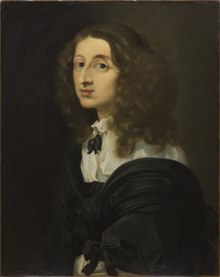Prague art theft
The Prague art theft is the capture of numerous works of art by the Swedish army at the end of the Thirty Years War .
The military situation
Although the negotiations for the Peace of Westphalia in the summer of 1648 were already in the final phase, the fighting continued, even if major battles - as in the early phases of the Thirty Years' War - largely failed to materialize. While the main armed forces of the imperial and allied Bavarians lay in the Electorate of Bavaria and, after the defeat at Zusmarshausen against the Swedish-French main army under Turenne and Wrangel , had withdrawn to the Inn , where they reorganized and waited for reinforcements, had a small part of the Swedish army under General Königsmarck to Bohemia turned and there on July 26, 1648, Prague's Lesser Town in the coup taken.
course


After Queen Christina of Sweden had received the success report on August 5th about the conquest of the Lesser Town in Prague, she wrote to her cousin, Count Palatine Karl (X) Gustav , who had been Swedish Commander-in-Chief since October 1648, with the request that “ To reserve ” Prague art treasures for the Swedish crown . A little later, Christina explicitly ordered in another letter to Karl Gustav that the most precious pieces of Emperor Rudolf II's collection be “taken into safekeeping ”. The objects she wanted were to be transported down the Vltava and Elbe to Mecklenburg and then across the Baltic Sea . Königsmarck has now been instructed to personally take care of the archives, libraries and art treasures, also with regard to logistics.
In the Prague art theft, not only the treasures of Prague Castle were looted and transported away , but also other palaces on Prague Castle Hill, such as B. the important Rosenberg library. The bronze sculptures of the Rudolfine court artist Adriaen de Vries from the garden of the Waldstein Palace were dismantled and stolen. The centerpiece, however, were large parts of the famous art collection of Emperor Rudolf II, which at that time was still considered the epitome of the princely understanding of art across Europe. Although several items from the Kunstkammer came to Vienna immediately after Rudolf II's death and shortly before or at the beginning of the Thirty Years' War , the Swedes came across over 700 paintings , including numerous works by the imperial chamber painter Frans Luycx . The Codex Argenteus and the Codex Gigas stand out from the looted valuable manuscripts .
At the scene of the peace negotiations taking place at the same time in Munster , the imperial envoys lodged a violent but unsuccessful protest. At the end of November 1648, the Prague art treasures, archives and libraries arrived at the Dömitz Fortress , where they were stored for the winter. On January 20, 1649 it was ordered that the booty should be brought across the Baltic Sea at the first open water. On April 14th the treasures finally reached Stockholm. Many of the paintings were subsequently distributed to the royal palaces around Stockholm, a large proportion of which is now on display in Gripsholm Palace.
literature
- Walter F. Kalina: Emperor Ferdinand III. and the fine arts. A contribution to the cultural history of the 17th century. Dissertation, University of Vienna, 2003.
- Susanne Tauss: "... that robbery is the most noble exercise ...". Art treasures as booty in the Thirty Years War, in: Klaus Bußmann, Heinz Schilling, 1648. War and peace in Europe. Exhibition catalog for the 26th Council of Europe exhibition on the occasion of the 350th anniversary of the Peace of Westphalia (Münster, Osnabrück 1999), volume II.
- Jenny Öhman (Uddevalla): The Looting of Prague 1648: A Swedish Perspective in: Early Modern Information 26, 2015, pp. 240–248.
Web link
- Jenny Öhman: The Sack of Prague 1648: A Swedish Perspective. In: Early Modern Information 26, 2015, pp. 240–248.
Individual evidence
- ↑ Susanne Tauss, "... that robbery is the most noble exercise ...". Art treasures as booty in the Thirty Years War , in: Klaus Bußmann, Heinz Schilling, 1648. War and peace in Europe. Exhibition catalog for the 26th Council of Europe exhibition on the occasion of the 350th anniversary of the Peace of Westphalia , Münster, Osnabrück 1999, Volume II, p. 286.
- ↑ Thomas DaCosta-Kaufmann: Courtyards, monasteries and cities. Art and culture in Central Europe 1450–1800 (Cologne 1998), p. 279.
- ^ Walter F. Kalina: Ferdinand III. and the fine arts. A contribution to the cultural history of the 17th century (dissertation University of Vienna 2003), p. 231 f.
